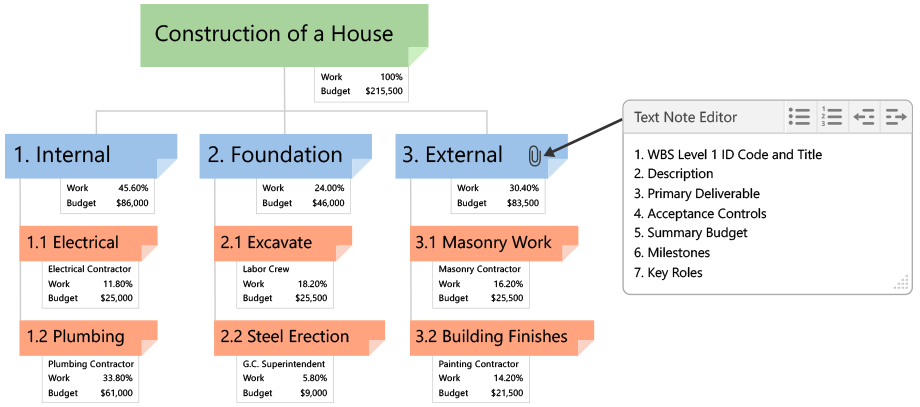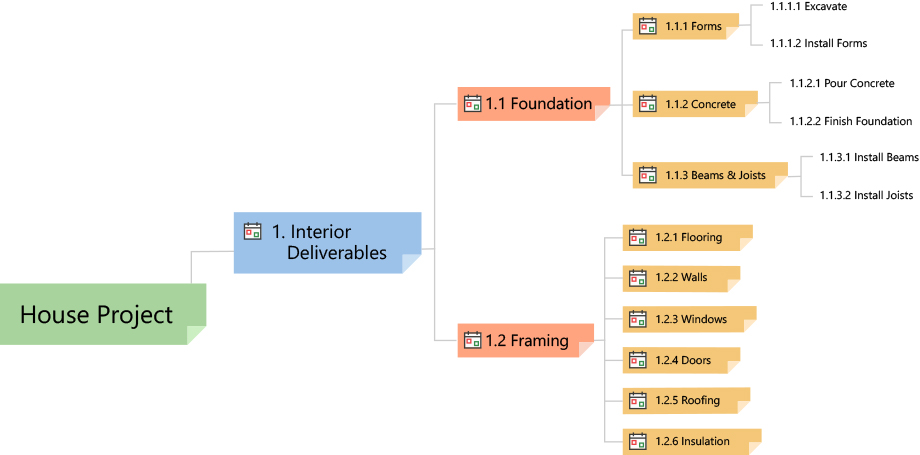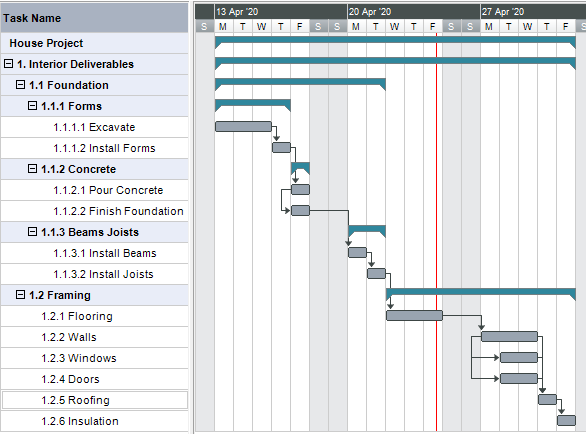This website uses cookies to improve user experience.

➔Free 30-day WBS Software Trial
The WBS Dictionary is one of three components that comprise the scope baseline: 1) the Scope Statement, 2) the Work Breakdown Structure and 3) the WBS Dictionary. Without a WBS Dictionary, the project does not have a complete baseline and cannot measure or monitor scope performance.
| No. | Item | Description | ||||
| 1 | WBS Code | Enter the WBS Title and identify it as a Work Package, Planning and/or Control Account. | ||||
| 2 | Responsible Organization/ Individual | Name the single organization, group or individual that has been assigned sole responsibility for making sure the Work Package is completed. Include contact information. | ||||
| 3 | Description | Define Work Package boundaries. Frame the scope content so that it is clear what scope is included and excluded. If it is a Planning Package, describe the known and unknown scope. | ||||
| 4 | Deliverables | Identify the product, service or results created when all of the work in this Work Package is complete. Include any critical intermediate deliverables. | ||||
| 5 | Acceptance Criteria | Describe the functional and physical requirements in order to meet customer expectations and quality requirements. Include any unique approvals required for acceptance. | ||||
| 6 | Budget | Designate the budget for this Work Package, plus any critical resource information and assumptions. | ||||
| 7 | Milestones | List any Start Dates, End Dates, Intermediate Milestones, Interdependencies, Constraints and any assumption for the deliverables. | ||||
| 8 | Risks | Include any known threats and opportunities with response strategies. | ||||
| 9 | Additional Information | Describe any additional information, such as references, related work packages, etc. | ||||
| 10 | Approvals: | Date: | Rev: | |||
The WBS Dictionary is the formal project document that provides detailed descriptions of key information for all Elements in the Work Breakdown Structure and must comply with the 100% Rule. The 100% Rule requires that the WBS captures 100% of the project scope. However, since the titles of the WBS Elements are only one or two words, it is impossible to confirm by just using the WBS that this rule has been met. The WBS Dictionary is the project document that describes the work in each Element such that the project team is able to plan and execute 100% of the scope.
Many references describe the WBS Dictionary as a Work Packages description tool. The Work Packages are defined as the lowest Elements in each Leg of the WBS. While this statement is true, the WBS Dictionary actually describes every Element in the WBS. The WBS Dictionary is created in a hierarchical format just like the Work Breakdown Structure. The Level 1 Element descriptions must be created first to understand its boundaries and ensure alignment with the lower level Elements. This is the best way to ensure that the 100% Rule is being followed.
After the Work Breakdown Structure has been approved, the WBS Dictionary can be created. The creation of the WBS Dictionary is led by the Project Manager and developed by project team members who are Subject Matter Experts (SME). The development approach begins with the Level 1 Elements, proceeds down each Leg and terminates with the Work Packages. This hierarchical approach ensures that the work within each Level 1 remains in alignment and compliance with the 100% Rule.
When creating the WBS Dictionary, it is important to keep the content of each Element brief. The primary purpose of the WBS Dictionary is for project team members to have a clear understanding of the work being performed in all the Elements and particularly the Work Packages. It is not a rewrite of the Scope Statement, a Work Authorization Package, a Contract or Agreement, etc. It is a concise explanation of important topics related to each Element. A good way to ensure this format is followed is to use a WBS Dictionary template while following these steps:
Assemble the project team SMEs and review the Work Breakdown Structure to validate the 100% Rule. Ensure everyone understands the WBS logic and assumptions. Revise the WBS based on feedback from the SMEs.
Using a template with the following minimum topics, create the content for each of the Level 1 WBS Elements (See Figure 1):
Return to the Work Breakdown Structure and check if the Level 1 Elements should be revised based on the newly created content from the WBS Dictionary. Confirm that the Level 1 Elements capture 100% of the scope.
Continue creating similar content using the same template for the remaining Elements down to, but not including the Work Packages. Adjust the content to reflect the respective Level of the Element; i.e., Level 2, 3, etc.
Using a template with the following minimum topics, create the content for each of the Work Package Elements:
Validate that the Dictionary adequately captures the scope required to produce the deliverable. Ensure that the WBS Dictionary reflects 100% of the scope.

Figure 1 – WBS Dictionary Level 1 Template
Just like the Work Breakdown Structure, the WBS Dictionary is a critical scope planning tool. It also serves as a basis for preparing work authorization documents, schedules, cost estimates and monitoring and controlling baselines. As mentioned many times in this article, it defines the work in the Work Breakdown Structure. It contains minimal essential information to understand the project requirements and meet all of the deliverables’ acceptance criteria. Combined with the approved scope statement and the Work Breakdown Structure, the WBS dictionary is the third and final component of the scope baseline. The baseline is the project document used to measure project performance. The scope baseline is the formal plan that is compared against actual results for monitoring and controlling scope execution.
Work authorization documents are prepared based on the Work Package information and used to execute work. The Work Package information in the WBS Dictionary provides the basic data required for the creation work authorization documents so that the deliverables meet the acceptance criteria and can be transferred to the customer. The Project Team should refer to the WBS Dictionary throughout project execution to ensure the deliverables meet requirements.
The WBS Dictionary is also the primary input for creating and monitoring schedule activities and cost estimates. Decomposing Work Packages create activities (See Figure 2). These activities become the activities that build a schedule using a Gantt chart format (See Figure 3). Once the activities have been resource-loaded, cost estimates can be created at the activity level, then aggregated via the Work Breakdown Structure throughout the entire project. This easily permits the project to monitor and control costs at any element in the WBS; a Work Package or Control Account.

Figure 2 – Decomposing Work Packages into Activities

Figure 3 – Creating a Gantt Chart directly from Work Package Activities